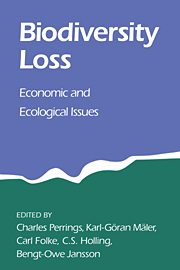Book contents
- Frontmatter
- Contents
- Foreword
- Preface
- List of contributors
- Introduction: framing the problem of biodiversity loss
- PART I CONCEPTUALISING DIVERSITY AND ECOSYSTEM FUNCTIONS
- PART II INTEGRATING ECOLOGY AND ECONOMICS IN THE ANALYSIS OF BIODIVERSITY LOSS
- PART III ECONOMIC ISSUES
- 7 Economic growth and the environment
- 8 The international regulation of biodiversity decline: optional policy and evolutionary product
- 9 Policies to control tropical deforestation: trade interventions versus transfers
- 10 On biodiversity conservation
- PART IV CONCLUSIONS
- References
- Index
9 - Policies to control tropical deforestation: trade interventions versus transfers
Published online by Cambridge University Press: 05 June 2012
- Frontmatter
- Contents
- Foreword
- Preface
- List of contributors
- Introduction: framing the problem of biodiversity loss
- PART I CONCEPTUALISING DIVERSITY AND ECOSYSTEM FUNCTIONS
- PART II INTEGRATING ECOLOGY AND ECONOMICS IN THE ANALYSIS OF BIODIVERSITY LOSS
- PART III ECONOMIC ISSUES
- 7 Economic growth and the environment
- 8 The international regulation of biodiversity decline: optional policy and evolutionary product
- 9 Policies to control tropical deforestation: trade interventions versus transfers
- 10 On biodiversity conservation
- PART IV CONCLUSIONS
- References
- Index
Summary
Introduction
Concerns about tropical deforestation have led to an increased focus on the role of the timber trade in promoting forest depletion and degradation. Recent reports suggest a marked increase in tropical deforestation in the 1980s, with the overall rate doubling from 0.6% in 1980 to 1.2% in 1990 (Dembner 1991). However, the deforestation rate varies across regions, with an estimated annual rate for Latin America of only 0.9% compared with 1.7% for Africa and 1.4% for Asia.
Despite concern over the state of tropical deforestation and its implications for global welfare, several recent studies have indicated that the tropical timber trade is not the major direct cause of the problem – perhaps less than 10% of total deforestation – rather, it is the conversion of forests for agriculture that is much more significant (Amelung and Diehl 1991; Barbier et al. 1994b; Binkley and Vincent 1991; Hyde et al. 1991). Nevertheless, it is clear that current levels of timber extraction in tropical forests – both open and closed – exceed the rate of reforestation (WRI 1992). Less than 1 million hectares, out of an estimated total global area of 828 million hectares of productive tropical forest in 1985, was under sustained yield management for timber production (Poore et al. 1989). Moreover, timber extraction has a major indirect role in promoting tropical deforestation by opening up previously unexploited forest, which then allows other economic uses of the forests such as agricultural conversion to take place (Amelung and Diehl 1991; Barbier et al. 1991).
- Type
- Chapter
- Information
- Biodiversity LossEconomic and Ecological Issues, pp. 260 - 282Publisher: Cambridge University PressPrint publication year: 1995
- 7
- Cited by



